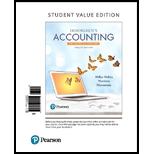
1)
a)
• Bonds are long term negotiable instruments of debt issued by corporate entities to secure funds from the public.
• These funds are used to either fund long term capital expenditure or similar long term investment opportunities.
• Bonds represent steady income for the investor in the form of periodic interest payments by the entity issuing the bond. Bonds are issued at par, at premium or at a discount.
• Bond Price is the maximum price that an investor will pay for a bond. It is calculated as the present value of the bond.
Price of $100000, 8% bond issued at 75.25.
b)
Bond Price
• Bonds are long term negotiable instruments of debt issued by corporate entities to secure funds from the public.
• These funds are used to either fund long term capital expenditure or similar long term investment opportunities.
• Bonds represent steady income for the investor in the form of periodic interest payments by the entity issuing the bond. Bonds are issued at par, at premium or at a discount.
• Bond Price is the maximum price that an investor will pay for a bond. It is calculated as the present value of the bond.
Price of $100000, 8% bond issued at 103.50
c)
Bond Price
• Bonds are long term negotiable instruments of debt issued by corporate entities to secure funds from the public.
• These funds are used to either fund long term capital expenditure or similar long term investment opportunities.
• Bonds represent steady income for the investor in the form of periodic interest payments by the entity issuing the bond. Bonds are issued at par, at premium or at a discount.
• Bond Price is the maximum price that an investor will pay for a bond. It is calculated as the present value of the bond.
Price of $100000, 8% bond issued at 94.50
d)
Bond Price
• Bonds are long term negotiable instruments of debt issued by corporate entities to secure funds from the public.
• These funds are used to either fund long term capital expenditure or similar long term investment opportunities.
• Bonds represent steady income for the investor in the form of periodic interest payments by the entity issuing the bond. Bonds are issued at par, at premium or at a discount.
• Bond Price is the maximum price that an investor will pay for a bond. It is calculated as the present value of the bond.
Price of $100000, 8% bond issued at 103.25
2)
Retirement of Bonds
• When a bond is issued at a discount or at premium or at face value, the amount to be repaid as the principal amount is the face value of the bonds.
• When a bond is issued at a discount, the difference between the issue price and the face value is the cost to be borne by the company.
• Bonds are issued at a discount when the stated rate of interest is less than the market rate of interest.
Which of the bonds will have maximum
Want to see the full answer?
Check out a sample textbook solution
Chapter 14 Solutions
Horngren's Accounting, The Financial Chapters, Student Value Edition Plus MyLab Accounting with Pearson eText - Access Card Package (12th Edition)
- Please explain the correct approach for solving this general accounting question.arrow_forwardUnion National Bank has an issue of preferred stock with a $6.20 stated dividend that just sold for $105 per share. What is the bank’s cost of preferred stock? Financial accounting problemarrow_forwardI need assistance with this general accounting question using appropriate principles.arrow_forward
- give me solution plzarrow_forwardWhat is the amount of total assets?arrow_forwardA man earned wages of $52,800, received $1,600 in interest from a savings account, and contributed $4,200 to a tax-deferred retirement plan. He was entitled to a personal exemption of $3,700 and had deductions totaling $5,400. Find his gross income, adjusted gross income, and taxable income. Accurate answerarrow_forward
- Calculate depreciation expense on the machinearrow_forwardPlease provide the correct answer to this general accounting problem using accurate calculations.arrow_forwardHarlow Co. is a merchandising company. Last month the company's cost of goods sold was $65,200. The company's beginning merchandise inventory was $12,500 and its ending merchandise inventory was $22,400. What was the total amount of the company's merchandise purchases for the month? Need answerarrow_forward

 AccountingAccountingISBN:9781337272094Author:WARREN, Carl S., Reeve, James M., Duchac, Jonathan E.Publisher:Cengage Learning,
AccountingAccountingISBN:9781337272094Author:WARREN, Carl S., Reeve, James M., Duchac, Jonathan E.Publisher:Cengage Learning, Accounting Information SystemsAccountingISBN:9781337619202Author:Hall, James A.Publisher:Cengage Learning,
Accounting Information SystemsAccountingISBN:9781337619202Author:Hall, James A.Publisher:Cengage Learning, Horngren's Cost Accounting: A Managerial Emphasis...AccountingISBN:9780134475585Author:Srikant M. Datar, Madhav V. RajanPublisher:PEARSON
Horngren's Cost Accounting: A Managerial Emphasis...AccountingISBN:9780134475585Author:Srikant M. Datar, Madhav V. RajanPublisher:PEARSON Intermediate AccountingAccountingISBN:9781259722660Author:J. David Spiceland, Mark W. Nelson, Wayne M ThomasPublisher:McGraw-Hill Education
Intermediate AccountingAccountingISBN:9781259722660Author:J. David Spiceland, Mark W. Nelson, Wayne M ThomasPublisher:McGraw-Hill Education Financial and Managerial AccountingAccountingISBN:9781259726705Author:John J Wild, Ken W. Shaw, Barbara Chiappetta Fundamental Accounting PrinciplesPublisher:McGraw-Hill Education
Financial and Managerial AccountingAccountingISBN:9781259726705Author:John J Wild, Ken W. Shaw, Barbara Chiappetta Fundamental Accounting PrinciplesPublisher:McGraw-Hill Education





